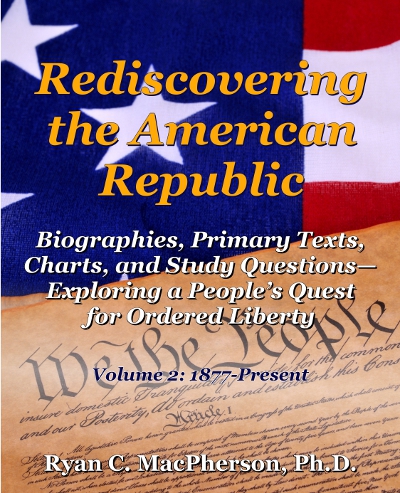Excerpted from: Rediscovering the American Republic, vol. 2: 1877–Present
Historians generally refer to feminist reform efforts of the 1960s through the 1980s as the “second wave” of American feminism. The “first wave,” beginning in the mid 1800s and continuing through the early 1900s, emphasized property rights and voting rights. Feminists of that earlier tradition generally were “maternalists,” rather than feminists in the modern sense. Recall, for example, that Jane Addams and Florence Kelley had taken on “mothering” roles in society as they advocated progressive reforms to improve the lots of families. Similarly, Frances Perkins, as Secretary of State under Franklin D. Roosevelt, shaped the Social Security Act of 1935 as a care-taking safety net for families, assuming the marital household with a male breadwinner as the norm. Thus, a widowed wife could receive retirement income based on the prior employment of her deceased husband. In this sense, public policy recognized the family—a husband and wife with their children—rather than the individual as the basic unit of society.
Following World War II, Americans became increasingly focused on their rights as individuals, rather than their well-being as families. Public policy shifted, with federal aid programs under the Great Society preferring to subsidize daycare and requiring that single mothers work, rather than the New Deal model of providing a replacement income for a disabled or deceased husband so that a mother could remain in the home with her children. Meanwhile, women themselves began to look for fulfillment beyond the family. First, however, they would need a new vocabulary for expressing these dreams.
Many historians regard Betty Friedan’s 1963 book The Feminine Mystique as the launching pad for the “second wave” of American feminism. Henceforth, the new generation of feminists would focus on access to contraception and abortion plus affirmative action policies for achieving gender equality in both education and employment. Friedan supplied the language for this new agenda by detailing, in her opening chapter, “The Problem That Has No Name.” According to Friedan, countless American women were not content to have the American dream of the 1950s: marriage to a gainfully employed man, children, and a nice house in the suburbs. Friedan went so far as to compare this domestic lifestyle to a Nazi concentration camp. She argued that women wanted, and deserved, something more—the same thing men already had: careers outside the home. Friedan thus opened a conversation and gave women a way to talk about their desire for higher education and full-time careers. The book became a bestseller, with women often meeting in groups to discuss its implications for their lives. Over the next few decades, the rate of full-time employment for women increased, as did the rates of cohabitation, divorce, contraception, and abortion and, for those children who were born, the rate of daycare enrollment.
Unknown to most American readers, the German psychologist Alexander Mitscherlich had published Society without the Father the same year as Friedan’s book appeared. Mitscherlich warned that the removal of the “working, teaching father” from the home, where he could model for children what meaningful labor is like, was already having a devastating impact upon children. For women also to leave the home, consigning children to daycare and all-day schooling, would deny children of both their parents for most hours of the day. Industrialization, in other words, had separated men’s work from family, thus separating working fathers from their children and delaying the natural process of social maturation. For women to leave the home as well would only compound the difficulty, especially when women discovered that paid employment outside the home seldom is as fulfilling as it may look from a distance.
Even as the second wave of feminism challenged earlier understandings of the parent-child relationship, it also offered a transformed vision for gender relations. Rather than celebrating the differences between men and women, feminism called for total equality. In 1966, Friedan founded the National Organization for Women, which advocated for the ratification of the Equal Rights Amendment (ERA), proposed in 1972:
Section 1. Equality of rights under the law shall not be denied or abridged by the United States or by any State on account of sex.
Section 2. The Congress shall have the power to enforce, by appropriate legislation, the provisions of this article.
Section 3. This amendment shall take effect two years after the date of ratification.
The states have never ratified the ERA. Instead, it became a wedge issue that divided liberal feminists in the Democratic Party from conservative guardians of family values in the Republican Party. On the one hand, the ERA echoed a longstanding American commitment to the principle of equality. On the other hand, one implication that troubled many women—and their husbands, fathers, and brothers—was the military draft. With the Vietnam War still fresh in people’s minds, were they really willing to demand that the federal government treat young women exactly like young men, sending them to risk their lives in combat?
- To learn more, purchase:
- See also:


